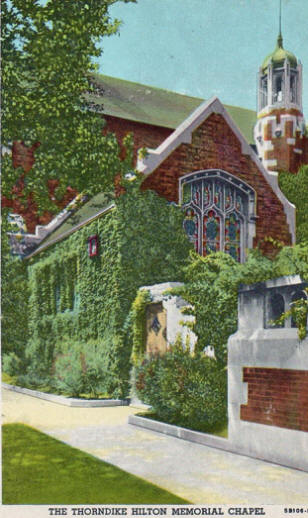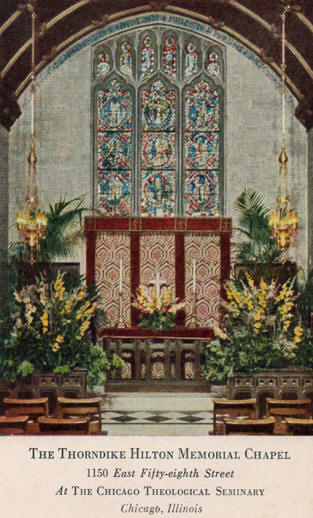…the thing I remember about him is he said that education is very important. He said, "Try to get as far as you can in education.’ And he was also interested in people relations and,...being active in the church and giving to the community and volunteering for whatever we could after we stopped working. He was also a very warm person, I remember his handshake. It was really warm. And he was just a very loving person.--Grace Watanabe Kimura
|
|
Paul Yorishige Watanabe
In the courtyard of Old GCU—It was there that I first met you!
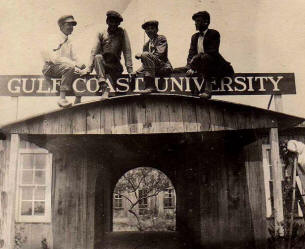 When
the faculty and students of the Gulf Coast University of Industrial
Arts made history when the college opened in September 29, 1909 in
Collegeport, Texas, little did they know that one of the students
was destined for great things beyond this small college. His name
was Paul Y. Watanabe, and though he was small of stature, he was
mighty of heart.
When
the faculty and students of the Gulf Coast University of Industrial
Arts made history when the college opened in September 29, 1909 in
Collegeport, Texas, little did they know that one of the students
was destined for great things beyond this small college. His name
was Paul Y. Watanabe, and though he was small of stature, he was
mighty of heart.
The exact circumstances that surrounded the arrival of Paul in the new town and college are unknown. The college was open to anyone who was eager for education whether they had funds available or not, as long as they were willing to pay for their tuition in honest labor.
Paul entered as a junior and was included in the list of the first class of 17 students in the college that not only offered a quality education, but a practical one.
It was the purpose of the school to keep the highest sane literary curriculum and at the same time fit the boy and girl for immediate useful work the moment they graduated. For instance, the boy would know how to manage a farm, or how to direct a working force in such a way as to get the greatest cheerful response from the force under his charge. He would be able to construct buildings. He was taught to successfully grapple with the problem of supply and demand and the proper distribution of products.
It was to this life that Paul committed himself as he pursued his education during the first two years of the college.
He was Collegeport's only Japanese resident.
Paul was enumerated with the Theodore Smith family in Collegeport in
the 1910 Federal Census. The family consisted of Theo, his wife,
Emma, and daughter, Grace. The students could board at the college,
but Paul was with the Smith family on April 15, 1910. Perhaps the
family “adopted” him and offered another opportunity for him to earn
the money he needed to fund his education.

Home of Theodore Smith in Collegeport where Paul lived with the
family.
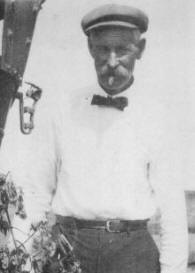 Theodore Smith |
 Emma Smith |
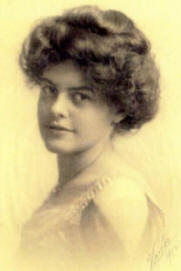 Grace Theodora Smith |
He was talented in music and participated in an end-of-year recital in June, 1910 as reported in the Collegeport Chronicle, June 8, 1910. The music department was well represented by a number of Junior students including Anna Van Ness, Kenneth House, Frank Travis and Edith Soekland, while Evelyn Kone, Vernon Hurd and Paul Watanabe gave more difficult selections.
He also worked in the home of Dena D. Hurd, wife of Collegeport founder, Burton D. Hurd.
Paul Y. Watanbe, since the close of school year of the University, has accepted a position at the home of Mrs. B. D. Hurd.--Collegeport Chronicle, June 3, 1910

Home of Burton D. and Dena Hurd
 Burton David Hurd |
 Dena D. Soekland Hurd |
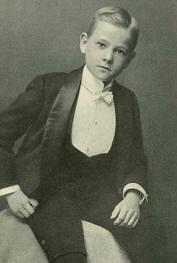 Vernon King Hurd |
Who was Paul Y. Watanabe other than a person who desired a
college education?
Paul was born on October 9, 1885 in Gifu, Japan on the island of Honshu. The family had been wealthy, but later their fortunes changed. Paul’s father died in an earthquake in Gifu when Paul was six-years-old. Some of the children were thrown out the window to save their lives. Paul’s leg was broken and the break would affect the leg all of his life.
Paul’s mother was left to raise seven children and placed some of the children in a Christian orphanage because she was unable to support all of them. He grew up in the orphanage where leaders also struggled to support the children in their care.
In an interview of his daughter, Grace Watanabe Kimura, Grace related some of what her father had told her.
…he said that when the orphanage was not very wealthy, and so a lot of times the children had to go out and sell pencils or other little things to bring a little money into the orphanage. And many times the children were made fun of because they were trying to sell things. So it was not an easy life, and a lot of times they didn't have enough food. And so I think it was a harsh bringing up.
Paul became acquainted with American missionaries Mr. and Mrs. D. H. Thornton at the orphanage Through them he was converted from Buddhism to Christianity. He was encouraged to immigrate to the United States which he did.. He courageously departed Yokohama in August of 1907 enroute to San Francisco on the ship S. S. Magnolia.
Paul arrived in San Francisco on August 27, 1907
and made his home in a Japanese community. He eventually realized
that if he wanted to learn English, he was going to have to live
outside of the Japanese-speaking community. He traveled to Texas and
registered at GCU in Collegeport for the inaugural term in 1909.
After leaving Collegeport, he attended the Bryan Baptist Academy at
Bryan, Texas, also a young college founded in 1905. Its purpose was
to provide a Christian education in music, art and languages.
Paul’s name appeared several times in the Bryan Daily Eagle as he participated in the Bryan Baptist Academy activities.
B. Y. P. U. Program, Solo in Japanese—Paul Watanabe, Bryan Daily Eagle, September 28, 1912
Rev. E. A. White, Paul Watanabe, Rev. L. M. Cole, Rev. I Watson, Rev. D. B. White and Rev. J. J. Pipkin left today to attend the State Baptist General Convention at Fort Worth., Bryan Daily Eagle, November 6, 1912
Cole, Rev. and Mrs. J. M. Bullock, Rev. Isaiah Watson, Paul Watanabe, and others have returned from the Baptist State Convention at Fort Worth., Bryan Daily Eagle, November 12, 1912
Bryan Baptist Academy
To the People of Bryan:
Come out to the Bryan Baptist Academy and be present at the prayer meeting in the chapel Friday night. These meetings are real revival meetings, the boys and girls confessing their sins and testifying to the power of Christ. Before long every student in our school will be saved.
Owing to the very unfavorable weather last Sunday, we could not attend Sunday School, so the girls, led by Mrs. McDonald, gathered in the dining room and the boys met in the chapel. We enjoyed the services very much. Sunday night Mr. Bullock led the prayer meeting, and it was one of the best meetings we have ever had. The Spirit was in the meeting, and a number of boys who had never before been moved made public confessions, and in tears testified. The influence of the prayer meetings that we boys are holding in our own rooms at night is having a wonderful effect on the school, and these hours are most precious to us.
I believe the Holy Spirit is with us, and that out of our school may go a spirit of revival which will move the entire city, and we want you to come and be with us and pray for us.
We have not been sending out any invitations, but nevertheless the door is always open, and if you are interested in us and our school we want you to come and be with us. The school is not only ours, but yours. And we want you to feel at home out here, and come oftener. We appreciate your talks and the good music, and you help us to grow both spiritually and intellectually.
Paul Watanabe – Bryan Daily Eagle, January 30, 1913
Even though Paul had moved on from Collegeport, he remembered his friends he left behind.
The July 18, 1913 issue of the Matagorda County Tribune reported Paul Wantanabe, our Japanese friend who attended the Gulf Coast University here for two years, now attending the Bryan College, is a visitor in Collegeport during the B. Y. P. U. encampment at Palacios, as a guest of Rev. M. A. Travis.
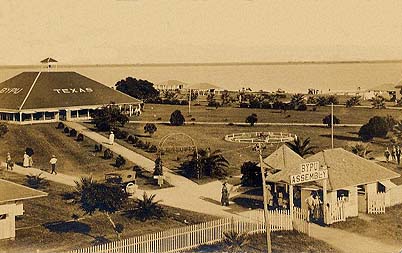
B. Y. P. U. Encampment at Palacios, Texas, which became the Texas
Baptist Encampment
Life for Paul in Bryan was busy as evidenced by the following
articles.
Rev. E. A. White and Paul Watanabe will spend Sunday in Wellborn.—Bryan Eagle and Pilot, April 24, 1913
Geo. Stephenson of the B. B. A., went to his home in Plantersville yesterday to spend Thanksgiving with his parents. He was accompanied home by Paul Watanabe, a schoolmate, who will be his guest.--Bryan Daily Eagle and Pilot, November 27, 1913
G. W. Stephens of the Bryan Baptist Academy is spending the week-end at his home in Plantersville. He was accompanied home by Paul Watanabe, who will be his guest during this visit.--Bryan Daily Eagle and Pilot, March 7, 1914
B. Y. P. U. Program
“How We May Know God’s Call.” Paul Watanabe--Bryan Daily Eagle and Pilot, May 16, 1914
|
Paul Watanabe has returned from a visit to George Stephens of Plantersville, a schoolmate at the Bryan Baptist Academy this session.--Bryan Daily Eagle and Pilot, May 29, 1914 Paul Watanbe went to Waco today to attend the National Baraca-Philiathea convention.--Bryan Daily Eagle and Pilot, June 6, 1914
Paul Watanbe has returned from Waco, where he attended the Baraca-Philathea convention.--Bryan Daily Eagle and Pilot, June 15, 1914 According to the Alumni Spotlight on Paul Y. Watanabe which appeared in the Hardin-Simmons Range Rider in the summer of 1992, Paul attended Baylor University from 1914 – 1917. Paul’s name and picture appeared in the Baylor University yearbook in 1915 as being in the Bryan Baptist Academy Club. |
|

Baylor University as it appeared near the time
when Paul was a student.
The Woman’s Club of Collegeport was treated to a visit from Paul on
January 1, 1917.
Instead of the regular program, a talk on
“Japanese Women” was given by Mr. Paul Watanabe, a Japanese. He
closed with a Japanese song.-- Woman’s Club minutes, Jan 25th 1917
Paul was enrolled in Simmons College in Abilene, Texas by 1918.
Paul Watanabe Speaks to Students In Chapel
Only Representative of Japanese Race in Simmons to Receive Degree in
June Delights Students and Faculty
with His Wit and Description of His Own Country
Paul Watanabe popular senior of Simmons college and the only representative of the Japanese race in this institution delivered. Saturday morning Nov. 2 on the most Interesting and witty talks made in chapel this year. He spoke for only fifteen minutes but during that time completely captivated his audience and caused them to demand his promise to address them again at a later date.
Mr. Watanabe spoke clearly and was understood without difficulty. His grammatical constructions were perfect and his talk was not marred by the accent that usually makes an address by a foreign born American so difficult to understand. He spoke briefly of the smallness of Japan and the immensity of her population-- how seventy million people are compressed into an area of less than 200,000 square miles less than the area of Texas. He told of the beauty of Japan, the land of flowers, which Bryan so aptly termed the "Paradise of the earth" when he visited that far eastern country several years ago.
Speaking of a long tour of the United States made this summer by him.
Mr. Watanabe told of a tremendous patriotic demonstration held by the population of Chicago on July 4 of this year. He stated that several hundred Japanese gathered in Jackson Park in that city and celebrated in true American style the Independence day of their adopted country. Speaking further he urged very briefly that the eastern countries be Christianized by representatives of their own race educated for that purpose.
Mr. Watanabe is spending his tenth year in the United States and his eighth in Texas. In 1908 he reached California from his native country. Shortly after he went to Chicago and after spending a short time there came to Bryan, Texas and two years later graduated from the Bryan Baptist Academy. He then attended Baylor University for two years and two years ago came to Simmons College and enrolled as a student. He will graduate with the June class from this school and expects then to enter Yale for a post-graduate course.
This summer Mr. Watanabe made a tour of the eastern and northeastern part of the United States as the Interpreter of a representative of the Japanese government to France who desired to see America while passing through the country. Mr. Watanabe left Abilene early in June first going to Hollister, Mo., where he attended a convention of the Y. M. C. A. as the representative of Simmons College. He then went to Chicago where he met the man to whom he was a traveling companion.
Among the places visited by the two were Detroit, Cleveland, Cincinnati, Richmond, Washington, Baltimore, Boston and New York at which last place they spent four weeks. They separated about the middle of August, the Japanese officer leaving for France, and Mr. Watanabe returning to Abilene.
Asked what impressed him most of all the things he saw on his extensive tour, Mr. Watanabe replied that Harvard University with Its eighty-one buildings and the Yale Library, with Its thirty miles of books had caused him the most wonder.
Simmons Brand, November 8, 1918
He gave an oration at Simmons Senior Day of 1919. A portion of his speech is included below.
Senior Day of 1919 An Historic One--Splendid
Orations Made
Watanabe Uses Japanese Entirely In Oration
Mr. Watanabe, the Japanese member of the class of ’19 spoke entirely in Japanese. This is a translation of extracts from his speech:
Ladies and gentlemen:
“It is a great honor for me to stand before you and speak to you as a member of class of nineteen hundred nineteen. It is a peculiar pleasure for me, because I have been struggling for last ten years in order to obtain the college education, and I am almost there. But when I think still further, my life’s task is not yet begun. I did not understand the meaning of the word “Commencement,” for a long time. What mean by commencement, at the end of the college career? But now, I understand, that it is a commencement for our life’s work, but what is the works of us the college men and women of today?...--The Simmons Brand, Abilene, Texas, March 1, 1919
| Paul was a member of the Ministerial Council at Simmons College.
The picture at right appeared
in
The four pictures below were |
 |
|
|
 |
|
|
 |
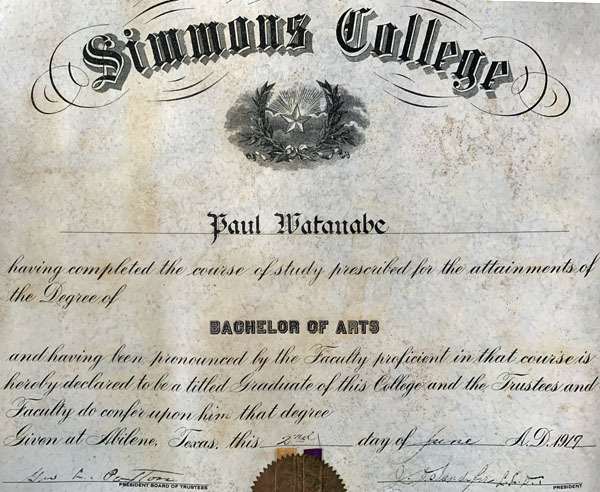 Photo courtesy of Kathryn Kimura Mlsna |
|
The next stop in Paul’s education was Yale University. He wrote the
following letter to Dr. Cooper at Simmons College in the fall of
1919.
Former Simmons Man in Yale
Paul Watanbe, one of the members of the class of 1918-19 of Simmons, is taking post-graduate work in Yale. The following is an abstract from a letter which Dr. Cooper recently received from him:
“Last Sunday morning President Hadley preached at the Woolsey Hall to the entire student body. Of course there were many visitors from outside. He spoke from the text, “And ye shall know the truth, and the truth shall make you free.”—John 8:32.
“Today Cardinal Mercier of Belgium came to Yale and spoke for a few minutes from the balcony of Woolsey Hall. The people all stood outside. Many people couldn’t come on account of bad weather. It is raining and cold all day. Like all other foreign people he had great difficulty in speaking English, but still he spoke wonderfully well. His face was shining with joy and gratitude of hearty welcome of the American people. He praised the American soldiers with great admiration. Tonight Yale is going to offer him great banquets, then Yale offer him the degree of Doctor of Law. Only Seniors and graduate students are invited.
“Tomorrow night Vatican choir of Rome, Italy, is coming and give concert at Yale Chapel. Tickets are $2, $3, $5 and $7. It is the most famous choir in the world, I was told.
“King Albert and Queen Elizabeth are going to pass here from Boston to New York, and they may stop here, too.
“I am taking political science and philosophy as my major courses. I have one course under ex-President Taft. He teaches the ‘Constitutional Law,’ and is certainly fine. He is a very common man. He walks on the streets of New Haven by himself and no one notices him as the former President of the Unites States.
“One other course I have under Judge Gager. He is the judge of the Supreme Court of Connecticut, and I like all my courses.
“We have about five Japanese students here, and three of them are studying for the ministry.
“Japan’s greatest preacher is coming to Yale to speak, in a few weeks. He is visiting Harvard now. He has just returned from Europe. He is called the Spurgeon of Japan. I knew him well in Japan and I am anxious to see him in America.
“I am planning to visit Japan next year with other students in Yale, for we have the “World’s International Sunday School Convention” meet in Tokio next October, and there are about 8000 people from America alone going, so it is the greatest epoch in Japan for the Christianization. Forty years ago they persecuted the missionaries, and now Japanese government is having S. S. Convention to meet in Japan. It is rather a great change.”—Paul Watanabe--Simmons Brand, Abilene, Texas, October 10, 1919
The second Federal Census enumerated on January 1, 1920 recorded Paul as a student with the Yale School of Religion.
1920 Census – Connecticut – New Haven – New
Haven Ward 1 – 108 College Street
Paul Watanabe, lodger, male, Japanese, age 26, single, alien born in
Japan, parents born in Japan, student
The 1919-1920 Catalogue of Yale University listed Paul as having a B. A. degree from Simmons College and currently attending Graduate School I.
At some point a letter of recommendation was written by George W. Truett which said in part, “My distinct impression of this young man is that he is altogether worthy and capable, and that in his efforts to prepare himself to be a missionary to his own people, he should have the sympathetic and practical cooperation of Christ’s people wherever he goes.”
M. F. Ham, another minister of the past, wrote of
Paul, “As a Christian character, I wish to say that I have never
met anyone who possessed more of the spirit of humility and
meekness, gratitude and appreciation than our friend and brother,
Paul Watanabe.”--Range Rider, Summer, 1992
By December 1920, Paul was in Japan and was doing evangelistic work
as evidenced in a letter written to Simmons College president, Dr.
Jefferson Davis Sandefer, Sr.
Contribution is Made for Simmons Alumnus Now Working In Japan
In response to a letter received last week by President Sandefer, a cash contribution amounting to $28.77 was made in chapel Tuesday morning to be sent to Paul Watanabe, alumnus of Simmons College, who is doing evangelistic work among his native people in Japan. Paul wrote President Sandefer that he was being heard by large crowds of people in Japan, but that the people were not so enthusiastic in their giving as they were in the listening, consequently he was in need of money in order to be able to proceed with his work. Paul graduated with the class two years ago, and went from Simmons to Yale where he did several months work, toward his master degree. During the summer he sailed for Japan where he attended the World’s Sunday School Convention at Tokio. He expects to spend several months in Japan working with his people before returning to this country finish his education.--Simmons Brand, December 11, 1920
The Brand editor is disappointed that the
students of Simmons College did not respond more freely to the
proposition to send a cash contribution to Paul Watanabe, an alumnus
of the college who is doing evangelistic work in his native country,
Japan. The fact that the collection was so small is probably due to
the fact that only a small number of students now in school were
here when Paul was a student in Simmons. We feel sure that had more
of our students known Paul they would have responded more freely to
the call to help bear his expenses while he is trying to carry the
religion and ideals of our country to Japan. Paul is gifted, humble
and consecrated to the cause of Christianity. He loves Simmons
College as but few of our students have loved her. We firmly believe
that some day he will become a constructive figure in the life of
that country, and the students and friends of Simmons College are
losing a fine opportunity to accomplish a great deal of good with a
contribution that will be insignificant when divided among several
hundred students.--Simmons Brand, December 11, 1920
In the 1920s, the United States began tightening its immigration
policies and the result was the Oriental Exclusion Act. The act
passed on April 12, 1924 and went into effect on May 26, 1924.
Paul Watanabe realized if he wanted to marry someone who was a Japanese native, he would have to immediately travel to Japan to search for a wife. After the Exclusion Act went into effect, no one from Japan would be admitted into the United States.
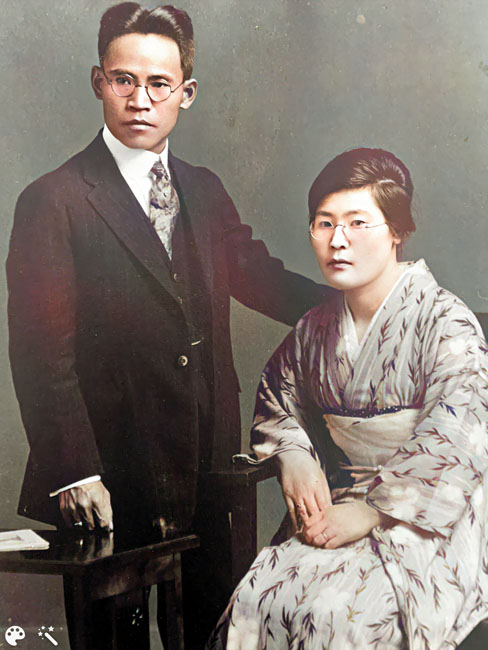 Paul
sailed back to Tokyo, Japan and spent a portion of his time speaking
at churches relating his impressions of America. He also announced
he was there to look for a wife. One of the men who heard him speak
had a tutor for his children in his household. The man asked the
tutor if she knew of anyone who would make a good wife for Paul. The
tutor, Hana, contacted her sister, Chie, who lived on Hokkaido, the
northern island of Japan. She encouraged her sister to travel to
Tokyo to meet Rev. Watanabe. After her train trip, she was
introduced to Paul. Their marriage followed a short courtship and
Chie returned to the United States with Paul.
Paul
sailed back to Tokyo, Japan and spent a portion of his time speaking
at churches relating his impressions of America. He also announced
he was there to look for a wife. One of the men who heard him speak
had a tutor for his children in his household. The man asked the
tutor if she knew of anyone who would make a good wife for Paul. The
tutor, Hana, contacted her sister, Chie, who lived on Hokkaido, the
northern island of Japan. She encouraged her sister to travel to
Tokyo to meet Rev. Watanabe. After her train trip, she was
introduced to Paul. Their marriage followed a short courtship and
Chie returned to the United States with Paul.
While living in Los Angeles, their first daughter, Grace, was born May 2, 1925. Jessie, their second daughter, was born in 1926 in Wintersburg, California and Ruth in 1930 in Los Angeles.
In an interview, Grace described their parents and family life.
…they were very loving people, very supportive and caring. And my father was a very gentle man, and he was a good speaker, he was a good raconteur, and he used to tell us all sorts of stories around the dinner table especially. And he was well-versed in world and politics and things like that. So it was fun listening to him. And then my mother, she was more quiet, but then she had a good sense of humor. I can remember her having good laughs. She used to laugh a lot, which helped her. She was very supportive of her husband and she was a very good wife and mother.
Chie understood English better than she could speak it, so the family conversed in Japanese at home and English outside of their home.
During the early years of their family, Paul worked for the Japanese Association which helped Japanese people get settled in the United States.
Later he was ordained as a minister and began his pastoral studies. He was the pastor of several Japanese churches.
On the 1930 census, Paul was recorded as a minister in a Baptist church.
The girls grew up Boyle Heights which had a multiethnic makeup of Japanese, Chinese, Hispanic, Jewish and Russian families. They played with the children of those families and enjoyed jacks, hide-and-go-seek, kick the can and skating.
The girls attended First Street School until they were in sixth grade. They also attended Japanese school five days a week after their regular schooling. The school was held in the Evergreen Baptist Church where their father was pastor.
Photo courtesy of Kathryn Kimura Mlsna
In 1932, Simmons College reached out to Paul and the following
August 6, 1932 issue of the Simmons Brand reported they had finally
located him after losing touch for 10 years.
SU Exe Located
Japanese Student Rates As All Time Popular Chapel Entertainer
Bad coins and good friends will always be heard from. This week an ex-Simmons student and the one chapel speaker for whom students actually clamored was heard from after being lost to friends here for twelve years.
Paul Wantanabe, a converted Japanese from Fifu [Gifu] and Tokyo, who graduated from Simmons in 1919 is now pastor of the Boyle Baptist Mission, Los Angeles, California, according to a message received here this week.
Watanabe went from here to Yale University where he did graduate
study. For more than a decade the alumni secretaries of Yale and
Simmons have been searching for him, and it was mainly through their
efforts that his address was finally learned. While he was a student
here the little Japanese was not only a favored speaker, but one to
whom all the students were devoted as a friend.
Baptists Of Southland To Convene
Friday will be given over largely to reports from
mission fields, to be given by Rev. Nicholas Dulity, Rev. Joseph
Napoli, Rev. Peter Pawluk, Rev. S. M. Ortegon and Rev. Paul Y.
Watanabe.--Los Angeles Times, October 17, 1933
In 1934, Chie and her three daughters made a voyage to
Japan to visit relatives. They sailed for two weeks on the South American ship
Montevideo. They first visited Paul’s parents in Gifu and them Chie’s family on Hokkaido. The girls were able to meet Chie’s
parents, brothers and sisters. After staying all summer, they sailed
from Yokohama, Japan on September 11, 1934 on the M. S. Asama Maru.
At that time be family was living at 2628 Gleason Avenue in Los
Angeles. The return passenger list recorded Chie and the girls all
had a dark complexion, black hair and brown eyes. It even gave their
height: Chie 5’ 1”; Grace 4’ 7”; Jessie 4’ 0” and Ruth 3’ 2”.
The family weathered a disaster when they experienced a house fire one Sunday morning that
destroyed their home. They stood across the street and watched it
burn.
After preaching at the Evergreen Baptist Church for several years, Paul resigned due to doctrinal differences with some of his church members. He founded the Fundamental Baptist Mission for the Japanese and received donations as his salary. The initial focus was on training children so they opened a kindergarten in their home. At one point they had approximately 50 students. Each day they heard Bible stories, enjoyed craft work and other activities. Chie prepared soup for their lunch.
Grace first attended Roosevelt High School in
Boyle Heights, but after a year she transferred to Huntington Park.
The Watanabes were the only Japanese students at Huntington Park.
Paul also preached at other churches while
conducting the Fundamental Baptist Mission.
Baptist
Rev. Paul Y. Watanabe of the Fundamental Baptist Mission to the Japanese will preach at 9:30 a. m. tomorrow at the Calvary Baptist Tabernacle.--Los Angeles Times, March 25, 1939
The Watanabe family was living at 3506 E 4th Street in Los Angeles at the time of the 1940 census. They had been living in the same house for at least five years. Paul’s occupation was listed at Baptist minister – Private day nursery and mission. Chie was a teacher in the Private day nursery and mission.
Grace was in her senior year of high school when the Japanese bombed Pearl Harbor on December 7, 1941. Following the bombing, the family felt uncomfortable because they were looked upon in a different light by others.
The Watanbe's schooling was going well and the time was soon approaching for the evacuation ordered by the U. S. government for Japanese in America. Paul was not feeling well and after returning from a trip to the Eastern United States, he went to the doctor. The diagnosis was cancer and he was too sick to evacuate with his family.
Ironically, Japanese Americans would be sent to internment camps, yet Paul was required to register for the World War II draft. The following information was reported on his registration on April 24, 1942:
Paul Yorishige Watanabe
Serial # U 319
Residence: 3546 E 5th Street, Los Angeles, California
Telephone: Angeles 4376
Age: 56 years; born October 9, 1885 in Gifu, Japan
Person who will always know your address: Chie Watanabe
Employer’s name: unemployed but Baptist Minister working under
Fundamental Baptist Churches of California
Description:
Race: oriental
Height: 5 ft 1 in; brown eyes; 102 pounds; gray hair; dark
complexion
crippled on left leg
Los Angeles, California
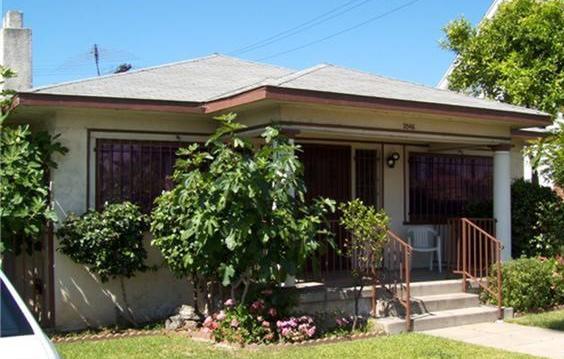
Home of the Watanabe family at 3546 E 5th Street, Los
Angeles, California before they had to evacuate to the internment
camp as it appears in 2020.
Courtesy of Google
When the family received the news of their evacuation, Paul was still at home, though very ill. He packed his library in crates and the Caucasian ministers stored them for him as well as some of the family possessions including Paul’s sermon notes. They sold their appliances and furniture and liquidated their household.
Soon after Pearl Harbor, Paul entered Los Angeles County General Hospital. Their Baptist minister friends appealed to the government to let the Watanabe family stay with Paul since he was so ill, but no special permission was granted. Paul underwent three surgeries and after the first surgery, Chie and the girls had to bid him goodbye to leave for the camp.
The Wantanabes and other residents who were evacuated from their neighborhood were loaded onto troop trains on May 29, 1942 not knowing where they were bound. They were guarded by MPs with rifles. The Watanabe family, except for Paul Y. Watanabe, was relocated to the Santa Anita assembly Centery (the racetrack) before being moved to Poston 1 on a Native American reservation in Arizona. The camp was still being built and the facilities were rudimentary.
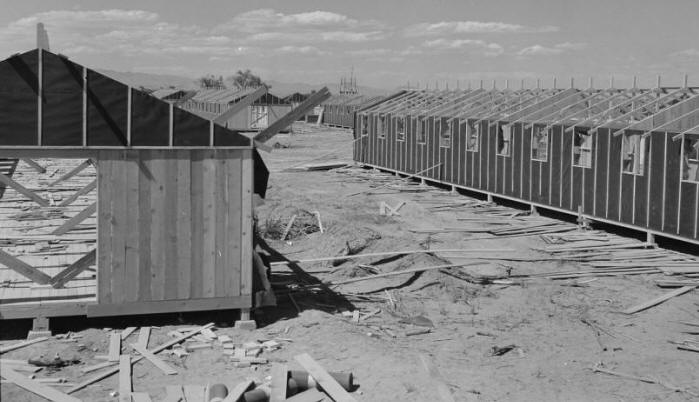
Poston internment camp under construction
Courtesy of Wikipedia
Their arrival and conditions under which they lived are best described in Grace's own words.
They gave us some cotton ticking materials, bags, and they said, "Okay, there's the pile of straw there, (you are going to) fill that up for your mattress." So we did the best we could, so it was not very comfortable. But I remember my mother saying that was really just the most forlorn feeling to first be taken out of your home and out of the state, and then (having) to stuff our own mattresses. It was very demeaning, but we did it.
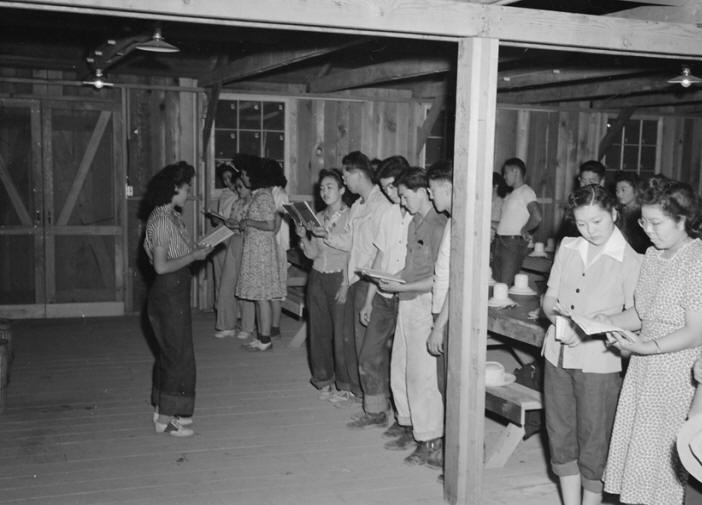
Church service at Poston 1 Internment Camp
Courtesy of Wikipedia
So after we stuffed our mattresses, then we were assigned rooms in each of these barracks,...divided into four rooms or apartments, they called it. And you had to have five in the family to deserve one room. But since there were only four of us, and we told them we expected our father to join us pretty soon, can we still, can we have one room? But they said no. And so we were put in this room, my mother and three daughters, and then with another couple, a man and his wife. Because there were just two of them, so they had to share it, and then there were only four of us, so we had to share. So we put a blanket across the room, and you can imagine six cots in that small area, it was smaller than 20 feet by 20 feet. So six cots in there. And so they had to serve as our bedroom, (and) living room, there was really no privacy.
Yes, complete strangers. So I kind (of) felt sorry for the man, he was the only man in that room. But it was very uncomfortable, and no privacy whatever. So in camp, everything was done community-style. We ate in the mess hall, and the latrines and the showers at the time we were there (were without) partitions. So it was awful. And then some of the older women who were very modest, would take showers during the midnight hours so that nobody could see them. And then the laundry had to be done by hand with washboards, I remember, my mother and other ladies in the laundry room doing the wash. And at the time I was there, there were no schools, they had not started up the schools yet. ...I think I helped in the mess hall peeling vegetables and carrots and potatoes. And so there was really not too much to do at that point. So my father had written from his sickbed to the people at Hardin Simmons University in Abilene, Texas...
Well, the only thing I remember was we
were fed lamb stew. We had lamb stew day in and day out, and the
meat was not tender, it was more like mutton, tough meat. And it had
carrots and potatoes in it, but it was not very tasty. But that's
what I remember, the lamb stew. So I don't like lamb to this day. It
just reminds me of camp. And I guess we had other things, but I
don't really remember. It was not too good.
Twenty-five days after Chie and the girls arrived at Poston, they
received word that Paul had passed away on June 21, 1942. They were
allowed to ride the train back to California to make the final
arrangements and attend the funeral service. They were the only
Japanese in attendance. When they returned to camp, the Japanese
ministers had another service for him. There were no flowers
available, so flowers were made from colored tissues in his
remembrance.
His ashes were buried in lot # 2844 at Evergreen Memorial Park Cemetery in Los Angeles on June 25, 1942.
Rev. Paul Yorishige Watanabe
Rev. Paul Yorishige Watanabe, late of 3546 East Fifth Street, beloved husband of Chie Watanabe, father of Grace, Jessie and Ruth Watanabe. Services Thursday, 3 p. m., from Calvary Baptist Church, One Hundred and Fourth Place and South Hoover. Utter-McKinley’s Broadway in charge.—Los Angeles Times, July 24, 1943
Deceased
Paul Watanabe, ’19,
popular Japanese student who gave his life to the ministry and who
was active in Japanese mission work in Los Angeles, California.
Watanabe had been in ill health for many years, and intimates say
that his death was hurried by his sadness over the treacherous acts
of Japan. Watanabe ’19 was survived by his wife and several
daughters. Plans are now in effect to see that these daughters are
educated in Hardin-Simmons University. Watanabe proved himself a
loyal American and a consecrated Christian.--Bulletin
Hardin-Simmons Ex-Student Roundup, September 1942
While on his sick bed, Paul wrote to his alma mater, Simmons College
in Abilene, Texas, which was then Hardin-Simmons University, to see
if they would accept his two oldest daughters, Grace and Jessie, on
scholarship. They needed to finish high school, and at the ages of
16 and 17, they were given permission to leave the camp. On
November 2, 1942, they left the camp to go to Abilene, Texas,
leaving Chie and Ruth behind.
Japanese Schoolgirls To Be Welcomed By H-SU Students
Grace and Jessie, teen age daughters of the late Rev. Paul J. Watanabe, Japanese missionary, are enroute to Abilene homes from a reception center at Poston, Arizona, where they have been living since the federal government ordered all aliens and their families removed from vital war areas. Grace and Jessie’s father worked among the Japanese people in California for many years and was a native of Tokyo. The girls attended Huntington Park high school in Los Angeles with a straight A national honor student rating. They both plan to attend Abilene high school.
Grace, the oldest, will be a senior in high school and she will live with Dr. and Mrs. W. R. White, president of Hardin-Simmons University, and Jessie, a junior will live with Mr. and Mrs. William McKnight Lewis of this city. They are the first students to be sent elsewhere to continue their high school work, though many have been sent to continue their college work.
Dr. White has known the late P. Y. Watanabe for over twenty years. Watanabe had been active in religious work in Texas for many years as well as in California. When Dr. White was on a speaking tour last spring he met Dr. Watanabe’s three daughters, one, Ruth, age 12 will remain in Poston where she will stay with her mother, at Los Angeles and when he returned to Hardin-Simmons he read a letter to the students in chapel from Mr. Watanabe asking that his daughters be allowed to attend Hardin-Simmons University. The student body gave its whole-hearted approval at that time.
Dr. White pointed out that a large number of Japanese are serving in the American Army, and many young Japanese are attending the colleges and universities throughout the land.
“This offers a splendid opportunity for us to demonstrate that the American way of life is on a much higher level than that of the countries we are fighting,” said Dr. White.
Their father, who died last July, was graduated with a B. A. degree in 1919. A native of Tokyo he had previously attended Baylor University which is located at Waco, Texas.
Hardin-Simmons University as well as Abilene high school has been approved by the war and navy department for student relocation and both girls will attend H-SU after their graduation from Abilene high school.
Grace and Jessie recently received a letter welcoming them to Abilene from Mayor Will W. Hair, in which the mayor assured them they would be cordially received here an intelligent citizenry that would not discriminate against them because of their Japanese parentage, while the nation is at war with Hirohito.
In reply, Grace, the older of the girls, wrote “we are not coming as Japanese, but as fellow Americans. Our father used to tell us, before he died to ‘pray about going to Hardin-Simmons,’” she said.
The sisters left Poston earlier this week and they are expected here this week-end.
H-SU Brand, Abilene, Texas, November 7, 1942
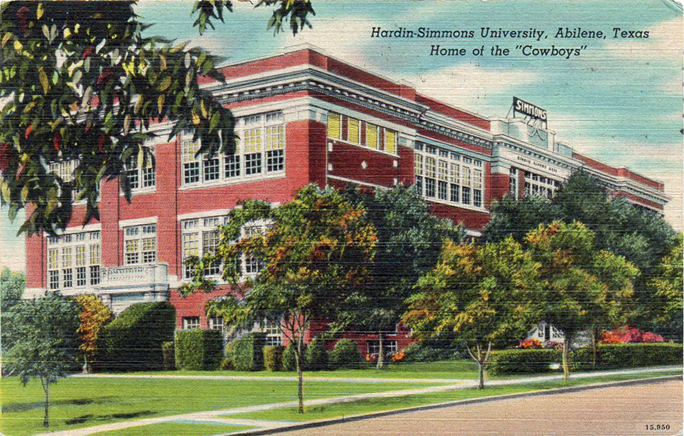

Photo courtesy of Kathryn Kimura Mlsna
|
On August 2, 1944, Chie and Ruth were able leave Poston I to join Grace and Jessie in Abilene. They got an apartment for their family and Chie took a job as a housekeeper for a family in Abilene.
Ruth attended North Junior High School and Abilene High School before attending Hardin-Simmons one year in 1946. |
|
Hardin-Simmons Student Wins Alpha Chi Essay Award at Meet
Success of Grace Watanabe
Hardin-Simmons university senior, in winning first place in the Alpha Chi essay contest last week was given special commendation in a report made to the HSU Round Table by Mrs. Otto Watts…
Miss Watanabe’s original essay, What I Can Do To Improve Racial Relations, ranked first in the social science division…
Miss Watanabe is a daughter of Mrs. Paul Watanbe of Abilene and ranks high in scholarship...
Abilene Reporter-News, Abilene, Texas, May 5, 1946
Watanabe Sisters Win High Honors
Jessie [Grace] Watanabe, 1946 graduate, was awarded the $25 cash prize during the commencement exercises for the best essay on the subject, "How Can I Improve Race Relations," given by Elta Campbell Roberts in memory of her sister, Willie Beatrice Campbell, a graduate of 1913.
Grace Watanabe, 1946 graduate, was the only graduate who received summa cum laude honors. Miss Watanabe also received the Julius Olsen medal, awarded each year to the graduate making the highest average during his or her college course, and the Delta Kappa Gamma given annually to the highest ranking student in the graduating class.
Jessie and Grace are daughters of Paul Watanabe, graduate in 1919, who died in 1942.
Bulletin, Hardin-Simmons University, Ex-Student Edition, June, 1946
NOTE: Grace also received the Minter Medal for earning the highest grade point average her senior year.
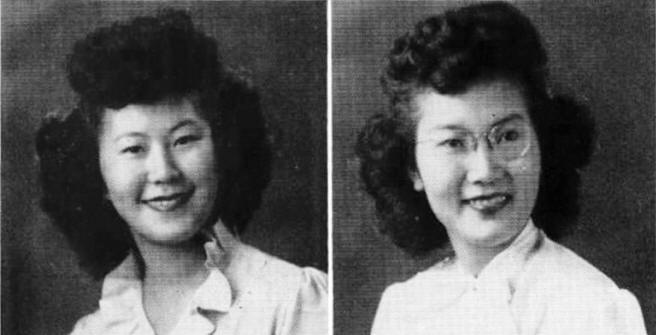
Jessie and Grace graduated from Hardin-Simmons in 1946
After her move to Chicago, Chie applied for naturalization. The
physical description on her application was:
Fair complexion; Brown eyes; Brown hair;
Height 5’ 1”; 135 lbs. Her residence was 4943 N. Sheridan RD,
Chicago, IL.
Ruth transferred to
Northwestern University in Evanston, Illinois.
When Jessie graduated from Hardin-Simmons, she
married Edward Saibara on September 1, 1946 at the Webster Community
Church in Webster, Texas. Her husband’s family members were pioneer rice
farmers in the Webster area. Jessie stayed in Texas and never lived
in Chicago with Chie, Grace and Ruth.
Watanabe-Saibara
Jessie Watanabe, daughter of Mrs. Paul Y. Watanabe, and Edward Siabara were married on Sunday evening, Sept. 1, at 7 o’clock, at the Webster Community Church, Webster, Texas.
Bulletin Hardin-Simmons University,
Ex-Student Edition, September-October, 1946
Grace graduated from Simmons College in 1946
with a degree in business administration. The Watanabes no longer
had ties to California, so Chie, Grace and Ruth moved to Chicago
because Chie had a sister and brother-in-law living there. The
relatives owned an apartment building in Chicago and Chie and the
girls were able to live in that building.
|
Chie remarried in Chicago to Araki Katsuno Mr. Katsuno was born at Fukuoka, Kunshu, Japan on January 17, 1887 and entered the US at San Francisco, CA on January 27, 1907. Mr. Katsuno was active in one of the churches. Chie was married to Mr. Katsuno longer than to Paul Watanabe. She joined her new husband in his business, Empire Art Products. A major portion of their business was the making of artificial flowers and leaves. The business was auctioned off in 1964.
The ad at right ran in the April 25, 1964 Chicago Daily News. |
|
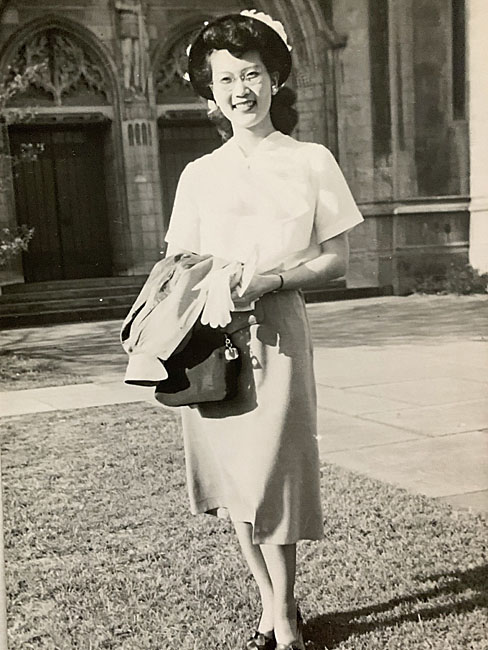
Photo courtesy of Kathryn Kimura Mlsna
Grace took a job at the Church Federation of Greater Chicago before
her marriage to Dr. Eugene T. Kimura on February 12, 1950.
Grace met her future husband, Eugene Kimura at a meeting of the Japanese American Citizens League. He was a student at the University of Chicago working on his PhD. He was born in Sheridan, Wyoming, but his family moved to Seattle, Washington when he was about six-years-old. He grew up in Seattle and attended the University of Washington. His education was interrupted in his second year when the evacuation order came. He and his mother were sent to Camp Harmony which was actually Puyallup Assembly Center, a temporary camp for Japanese Americans from Western Washington and Alaska. They stayed at Camp Harmony approximately two months. Eugene had a friend in Wyoming who encouraged Eugene and his mother to return to Sheridan, Wyoming. He earned his bachelor’s and master’s degrees at the University of Nebraska before moving to Chicago where he earned his Ph. D in pharmacology at the University of Chicago.

Camp Harmony - Puyallup Assembly Center
Courtesy of Wikipedia
|
|
Eugene and Grace dated about two years and were married at Thorndike Hilton Memorial Chapel which was a part of the Chicago Theological Seminary on the University of Chicago campus on February 12, 1950. They moved to New York City following their marriage. Watanabe – Kimura Grace Watanabe, ’46, became the bride of Dr. Eugene T. Kimura on Sunday, February 12, at the Thorndike Hilton Chapel in Chicago, Illinois. They will live in Yonkers, New York.--Range Rider, Volume 4, Number 3, March, 1950 Their two daughters, Kathryn and Eugenie, were born in New York and the family moved back to Chicago when the girls were two and three. Eugene was working for Abbott Laboratories in Chicago. Grace and Eugene were living at 6412 South Ellis Avenue, Chicago 37, Illinois in March, 1950. Their son, Alan, was born in Chicago. On September 28, 1956, Grace and Eugene lived at 934 Franklin Avenue, Winthrop Harbor, Illinois. They both worked until their retirement in 1989. At right, interior
of Thorndike Hilton Memorial Chapel |
|
Ruth met Paul Morimoto at Northwestern University in Evanston,
Illinois. They were married in Cook County on March 14, 1952.
While working 3 jobs, Paul received his
M.D. at the University of Illinois. During this time, his first
son, Steve, was born. Paul then completed an Ophthalmology
residency at Cook County Hospital and during that time also served
as team physician for the Chicago Cubs. Ruth and Paul were
living at 1636 West Jackson Boulevard, Chicago, Illinois on
September 28, 1956. Following his
residency, the family of 3 moved to Joliet, IL where Paul joined the
Ophthalmology practice of Robert W. Lennon in 1960. Shortly
thereafter, his second son, David, was born. While starting his
practice in Joliet, Paul faithfully and proudly served in the
Illinois National Guard Reserve for 7 years.
Chie Watanabe Katsuno took her Oath of Allegiance to become an
American citizen in Chicago on August 10, 1954.
On October 2, 1970, Chie’s husband, Araki, passed away and was buried at Montrose Cemetery in Chicago.
On October 16, 1974, wanting the family to be
buried together, the Watanabe family worked with Scanlon Funeral
Home in Chicago to remove Paul’s ashes from Evergreen Memorial Park
in Los Angeles, to Montrose Cemetery.
In 1980 the U. S. Congress appointed nine people to the Commission
on Wartime Relocation and Internment of Civilians to conduct an
official governmental study into the internment of Japanese
Americans during World War II. When the commission visited Chicago,
Grace Watanabe Kimura testified at the public hearing. The Office of
Redress Administration, established in 1988, was charged with
administering tax-free restitution payment of $20,000 to eligible
individuals of Japanese ancestry who were subjected to evacuation,
relocation and internment during World War II.
The $20,000 reparation payment did not begin to compensate the people for the loss of their homes, property, businesses, and the disruption of their lives and education, and friendships. It was more symbolic, and supplemented the official apology that the U.S. government issued for the incarceration of the 120,000 Japanese and Japanese-Americans.
Japanese-Americans Remember Texas College With
Gift
December 9, 1991
ABILENE, Texas -- Two Japanese-American sisters who were allowed leave a U.S. internment camp during World War II to attend Hardin- Simmons University have donated $7,500 to the school, officials said Monday.
Grace Watanabe Kimura of Morton Grove, Ill., and Jessie Watanabe Saibara of Webster, Texas, said the gift was from 'redress funds' they received from the U.S. government as an apology for their detention.
The sisters lived in Los Angeles in 1942 where their father, the Rev. Paul Y. Watanabe, was a Baptist minister. About 120,000 Japanese- Americans on the West Coast were evacuated to internment camps in the United States.
'Our family's reaction to the order to evacuate was one of disbelief and sadness because my father was seriously ill and probably would not be able to move with us,' said Kimura.
Their father was seriously ill with cancer and died within a month. From his hospital bed, however, he had written friends at Hardin- Simmons, where he had graduated in 1919, asking if his two daughters could attend the Baptist school on scholarship.
Hardin-Simmons welcomed the two girls to Abilene from an Arizona internment camp. Their mother and younger sister, Ruth, were able to join them two years later in Abilene. The two older sisters completed their high school education in Abilene and then attended Hardin-Simmons where they graduated in 1946.
'The people at school were very cordial and kind to us, accepting us as 'Paul's daughters' but whenever we went into town, we were stared at by people who had never seen Japanese people,' said Kimura.
The sisters told Hardin-Simmons President Lanny Hall they were making the gift to 'express our undying gratitude to HSU for welcoming us with open arms during a difficult period in the life our our family and for helping us to receive a strong Christian education.'
HSU will receive $1,000 from the Matching Grants Program of the G. D. Searle and Co. of Skokie, Ill., where Grace retired in 1989. Jesse is a retired postal clerk and makes her home in Webster, Texas. Ruth lives in Joliet, Ill.
|
|
|
Japanese-American Sisters’ Gift Boosts Loyalty Fund Scholarship
Two Japanese-American sisters who attended Hardin-Simmons University during World War II have given $7,500 to the institution’s Loyalty Fund from “redress funds” that they received from the United States Government.
The Loyalty Fund provides scholarship assistance for current and prospective students.
The donors are Grace Watanabe Kimura of Morton Grove, IL, and Jessie Watanabe Saibara of Webster, TX, who came to Abilene and enrolled initially in Abilene High School after Japan and the United States were engaged in war. Grace finished AHS in 1942 and her sister, one year later.
The announcement from HSU concerning the gift has been used by United Press International and by the Baptist Standard, official news journal of the Baptist General Convention of Texas.
The sisters said they are giving the funds to HSU “so that some deserving students might receive an outstanding Christian education just as we did.
The $7,500 is part of a redress payment that we Japanese-American survivors of the evacuation of 1942 have just received from the United States government as an apology for the wrongful action that was taken,” the sisters wrote in a letter to HSU President Lanny Hall.
“The gracious spirit of these generous graduates of HSU demonstrates the love and loyalty they have toward this institution. We are grateful that the leadership at HSU during that critical time in our nation’s history exercised a compassionate concern for these fine young students who were the daughters of a Baptist minister and an early day graduate of our school,” said Dr. Hall.
In May 1942 some 120,000 Japanese-American residing on the West Coast in Washington, Oregon and California were evacuated by the U. S. Government for internment camps in the interior of the United States.
“At the time, our family lived in Los Angeles where our father, Rev. Paul Y. Watanabe (a 1919 graduate of Simmons College) was a Baptist minister,” they explained.
“Our family’s reaction to the order to evacuate was one of disbelief and sadness because my father was seriously ill…and probably would not be able to move with us. I distinctly remember his praying fervently that his illness could be healed so that he could be with his family,” Mrs. Kimura said.
At the time of the order for evacuation came, the Rev. Watanabe was seriously ill with cancer and could not be moved. He died within a month.
‘From his hospital bed he wrote to friends at HSU, asking whether the two oldest of his three daughters (Grace and Jessie) might be able to attend HSU on scholarship after we had completed high school,” the sisters said.
The president of HSU at the time was Dr. William R. White, who would later become president of Baylor University, who wrote back, welcoming the girls to Abilene.
The girls were interned to a camp in Arizona. “We were the first high school students to be allowed to leave camp,” they said.
“We were frightened of the unknown, but went out in faith,” said Grace, who was 17 years old at the time and her sister, 16.
They lived with two families (Grace with the Charles Atkinson family and Jessie with the Harry Hayes family.)
Grace said, “The people at school were very cordial and kind to us, accepting us as ‘Paul’s daughters,’ but whenever we went into town, we were stared at by people who had never seen Japanese people,” said Mrs. Kimura.
Their mother, who is now beyond 90 years of age and lives in a retirement home in Chicago, and younger sister, Ruth, were able to join them two years later. Ruth attended HSU for one year in 1946 before transferring to Northwestern University in Illinois.
She also attended North Junior High School and AHS for one year before moving with the family to the Chicago area. Ruth and her family live in Joliet, IL.
“We applied ourselves seriously to our studies and made many good friends at school and at First Baptist Church and University Baptist Church,” the pair said.

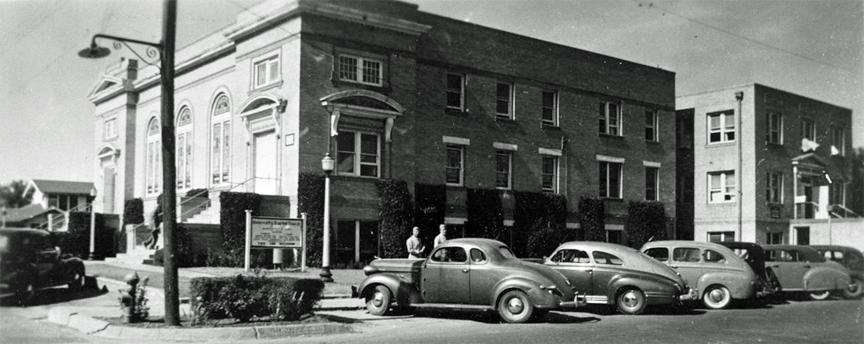
University Baptist Church, Abilene, Texas
Grace was awarded the Julius Olsen Medal for making the highest grade point average during her four years and also the Minter Medal for making the highest grade point average in the senior class. She attended a reunion of the Olsen Medalists at HSU in 1986 on the Abilene campus.
They told the president in a recent note they were making the gift “to express our undying gratitude to HSU for welcoming us with open arms during a difficult period in the life of our family and for helping us to receive a strong Christian education.”
HSU will receive $1,000 from the Matching Grants Program of the G. D. Searle and Co. of Skokie, Ill., where Grace retired in 1989 as executive secretary and also worked earlier as an administrative assistant at the Northern Trust Bank of Chicago. Jessie worked for the U. S Postal Service and makes her home in Webster, TX.
This letter concludes, “Thank you very much, Hardin-Simmons!”
Range Rider, Hardin-Simmons
University, Spring 1992
Paul Watanabe spent only two years of his life of 55 years in
Collegeport attending the Gulf Coast University of Industrial Arts,
but he was often remembered fondly by his Collegeport friends. They
had no idea that this new U. S. resident was destined to become a
Baptist minister and spread the word of God across the United States
and Japan.
Watanabe - Kimura
Apartments Dedication
Hardin-Simmons University
November 13, 2021
Information courtesy of Kathryn
Kimura Mlsna
Granddaughter of Paul Watanabe

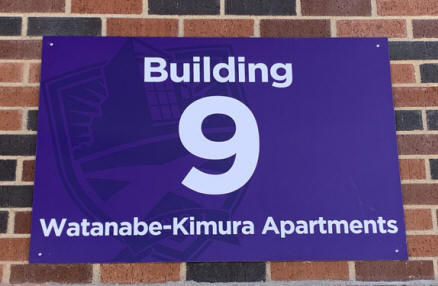
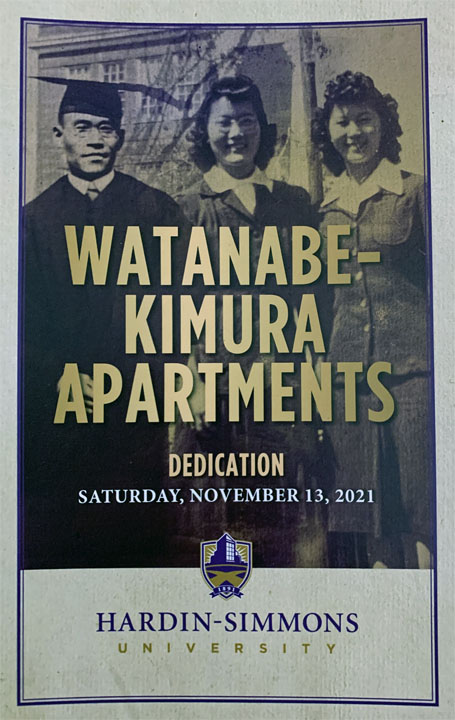 |
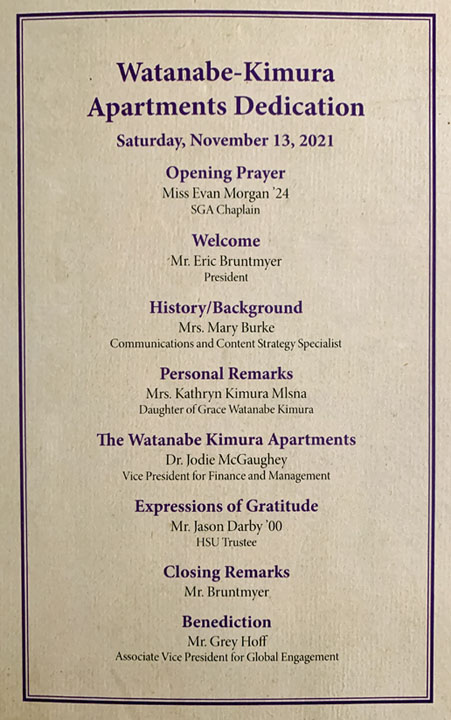 |
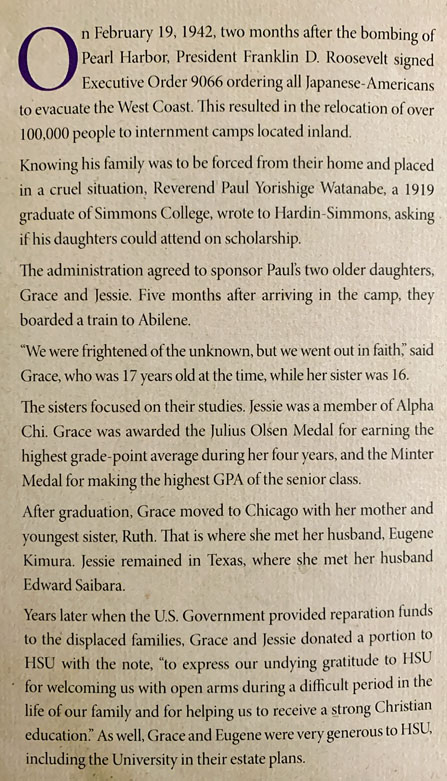 |
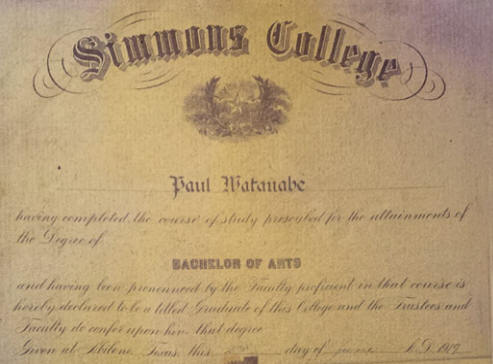 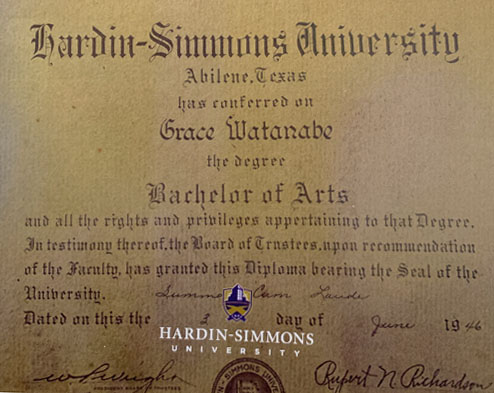 |
Additional Articles about the Watanabe Family
News In Brief
President and Mrs. White and Mr. and Mrs. Wm. M. Lewis (Nena Kate Ramsey ’21) gave homes to Grace and Jessie Watanabe, daughters of the late Rev. Paul J. Watanabe, ’19, Japanese Christian missionary. The girls have been in the reception center, at Poston, Arizona. The Bulletin is glad to report to Hardin-Simmons ex-students that plans are now under way to see that both of these splendid girls, who only want to be judged as fellow Americans, will receive their college training in Hardin-Simmons University as soon as they have completed the requirements of Abilene High School. Mayor Will W. Hare, of Abilene, wrote to Mrs. Watanabe and the girls assuring them that they would be most cordially received. In a reply, Grace, the older of the girls, said “We are not coming as Japanese but as fellow Americans. Our father used to tell us before he died to pray about going to Hardin-Simmons.”--Bulletin Hardin-Simmons Ex-Student Roundup, November 1942
Romance of Hardin-Simmons University, Chapter 16, page 86
Then there was Paul Watanabe, all 115 pounds of him, as lovable a Christian character as we ever met from any race or nationality. Paul had a struggle with the English in our textbooks, especially the chemistry and geology books. It took two rounds to get the chemistry grade for him to graduate in 1919. But what a brilliant mind! His work in Simmons College was accepted at Yale, where he received another degree; he came back to our seminary, then went to Japan as a missionary. He selected his wife in the American way and brought her back to San Francisco for mission work there, hoping to rear a family and enjoy the freedom ad fellowship of home life as a spiritual-minded American.
A few years after two lovely little girls came into this happy home, the ugly spectrum of World War II raised its dirty head. Paul and his family loved America; but in war, law is no respecter of persons, and the Watanabes were thrown into a concentration camp in Arizona with other Japanese. However, Paul Watanabe and his wonderful Christian life were well remembered—not only by the faculty and students, but by the trustees and the community of Abilene. C. M. Caldwell, for many years a trustee, and one of our school’s greatest benefactors, took the lead in trying to do something for the Watanabes. He enlisted the Red Cross, congressmen, and the commanding general of every military camp in Texas. Paul’s two teen-age girls were brought to Abilene under Caldwell’s guardianship; they finished high school and Simmons University after World War II had ended. Paul and his wife were given more liberties, and he spent most of his time teaching and preaching among his fellow Japanese in the camp. He told them that the time would come when they would love and respect America. Only the Lord knows how much more good he did than he might have done had his liberty not been restrained. If we could expand on this story, it might be judged the most romantic bit in all of our letters. [Paul was never a resident of an internment camp.]
Mrs. J. L. Anthony Provides ‘Home’ for Foreign Students
“The Little United Nations Assembly” is the name which has been given to Mrs. J. L. Anthony’s home at 2133 Simmons Ave, by Hardin-Simmons University students.
This name is the result of Mrs. Anthony’s home being the Abilene home of a number of foreign students in recent years. The three Hardin-Simmons students presently living there bring to 11 the total of foreign students who have lived with “Mom” Anthony since World War II.
They are James Hiarate, a special student from Honolulu; Laiz Lessa, a special student from Rio de Janeiro; and Chon Dong, a graduate student who is a native of North Korea.
A resident of Abilene for almost 32 years, Mrs. Anthony first opened her home to foreign students during World War II. They were the two daughters of Paul Watanabe, a native of Japan who graduated from Hardin-Simmons in 1920 [1919].
Watanabe was pastor of one of the largest Baptist churches of California when war broke out. Government orders for aliens to evacuate the West Coast found Watanabe dying of cancer in a California hospital.
Asked Dr. White Aid
The government would not allow Watanbe’s family to stay with him, so he wrote W. R. White, then president of Hardin-Simmons for permission for his daughters to attend H-SU. Dr. White granted the request and assumed personal supervision of the two girls.
Mrs. Anthony says, “It must have been the Lord’s
will for me to take in those two girls, because any former roomers
moved out the same day Grace and Jessie Watanabe arrived in Abilene.
They couldn’t find another place in town to stay.” ...--Abilene Reporter-News, November 4, 1951
Additional Watanabe Family Obituaries
Chie Watanabe Katsuno
June 2, 1901 Sapporo, Japan - February 18, 1994 Chicago, Cook
County, Illinois
Buried Montrose Cemetery, Chicago, Cook County, Illinois
Araki Katsuno
January 17, 1887Fukuoka, Kunshu, Japan
- October 2, 1970
Chicago, Cook County, Illinois
Buried Montrose Cemetery, Chicago, Cook County, Illinois
Death of Grace Watanabe Kimura
Grace Kimura, age 93, of La Grange Park, IL passed away after a short illness. Beloved wife of Dr. Eugene Tatsuru Kimura, dear mother of Kathryn (Timothy) Mlsna of Oak Brook, IL, Eugenie (Dr. Eugene) Chiu of Burr Ridge, IL and Dr. Alan Kimura of Denver, CO.; loving grandmother and great-grandmother. A memorial service and reception will be held on March 24, 2019 at 4:00 p.m. at Plymouth Place, 315 N. LaGrange Rd., LaGrange Park, IL, 60526. In lieu of flowers, memorials in her name to the Japanese American Service Committee, 4427 N. Clark Street, Chicago, IL 60640, would be appreciated. Arrangements entrusted to Hallowell & James Funeral Home, Countryside.--Chicago Tribune Media Group Publication, March 21, 2019
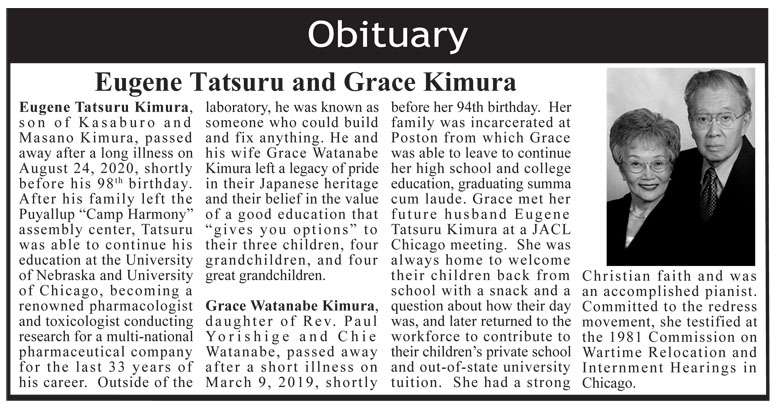
Chicago Simpo
Photo courtesy of Kathryn Kimura Mlsna
Edward Saibara, 92, passed away August 20, 2012. He was born February 13, 1920 in Webster, Texas and lived his entire life there. He was preceded in death by parents Kiyoaki and Shimoyo Saibara, brother Robert and wife Rola Saibara, sister Mabel and husband James Hisatomi, brothers Webster, Warren and Harvey Saibara. His most tragic loss was of daughter Susan Joy, who passed away April 10, 2011.
He is survived by his loving wife Jessie to whom he was married just short of 66 years, son Paul Saibara and daughter Sandra. Also, three grandchildren, Katie of Wellesley, MA, Emily and Andrew of The Woodlands. Other survivors are sister-in-law Mari Saibara of Houston, nieces Phyllis Ogden of Houston, Judy Ferguson of San Clemente, CA, Margie Saibara of Houston, Nancy Naritomi of Houston, and nephew James Hisatomi of Bellevue, WA.
Edward attended Webster schools and Texas A&M. He was an avid fan of Aggie football and was a member of the 12th Man Foundation for 37 years, attending all home games. His ancestry dates back to the early 1900's when his grandfather Seito Saibara emigrated from Japan and pioneered seed rice growing on the Texas Gulf Coast.
He was involved in rice farming and raising Santa Gertrudis cattle for many years. With the coming of NASA, he went to work for various contractors there until his retirement.
Visitation will be on Wednesday, August 22, 2012
from 6pm to 8 pm, at Forest Park East. Funeral service will be held
on Thursday, August 23, 2012 at 10am, with interment to follow.
Everyone is welcomed to the reception following burial at the
Webster Senior Center. The family wishes to thank Light Heart Memory
Care Facility and nurses at the Heart Tower in Clear Lake Regional
Medical Hospital for their kind and compassionate care.
In lieu of flowers, remembrances may be made to a charity of your
choice.
Houston Chronicle, Aug. 22, 2012
Jessie Watanabe Saibara
June 6, 1926 – January 22, 2023
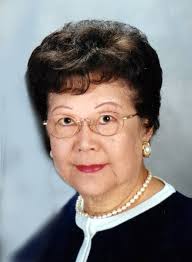 Jessie Watanabe Saibara, aged 96, beloved wife, mother and grandmother
passed away peacefully on Sunday, January 22, 2023 in Clear Lake City
(Houston, TX). She was preceded in death by parents Reverend and Mrs.
Paul Y. Watanabe of Los Angeles, CA, her beloved husband of 66 years
Edward Saibara of Webster, TX and dear daughter Susan Joy Saibara of
Houston.
Jessie Watanabe Saibara, aged 96, beloved wife, mother and grandmother
passed away peacefully on Sunday, January 22, 2023 in Clear Lake City
(Houston, TX). She was preceded in death by parents Reverend and Mrs.
Paul Y. Watanabe of Los Angeles, CA, her beloved husband of 66 years
Edward Saibara of Webster, TX and dear daughter Susan Joy Saibara of
Houston.
She is survived by son Paul Edward Saibara of The Woodlands, TX, daughter Sandra Kay Saibara of Houston and three precious grandchildren, Katie Saibara of Boston, MA, Emily Saibara of Baton Rouge, LA and Andrew Saibara of The Woodlands, TX. Also surviving are sister Ruth Morimoto of Joliet, IL and many nieces and nephews in Illinois and Houston.
Jessie was born in Huntington Beach, CA but grew up in Los Angeles until 1942 when her family and over 120,000 people of Japanese descent living on the West Coast were forcibly removed from their homes and confined in internment camps inland, in her family’s case Poston, AZ. Thanks to her father’s thoughtful planning she and her older sister Grace as young teenagers secured sponsors and were permitted to leave the camp, under the watchful eyes of the U.S. military, to relocate to Abilene, TX where they graduated from Abilene High School and in the top 10% of their class from Hardin-Simmons University which was also their father’s alma mater many years before. Jessie completed her studies in 3 years so she and Grace could graduate together, at a time when very few women attained college degrees.
After graduation she worked in Chicago before marrying Edward Saibara, a native of Webster, TX. He was the grandson of Seito Saibara, former president of Doshisha University in Japan, who was among early settlers on the Texas Gulf Coast in the early 1900’s and who introduced rice farming to the region. Edward and Jessie made their home in Webster where they raised 3 children, Paul, Susan and Sandra. Thanks to Edward she became an avid Texas A&M football fan and she and Edward attended all the home games for many years. Their 3 children were all graduates of Texas A&M.
Jessie was a long-time employee of the U.S. Postal Service where she served the public at the Webster Post Office until her retirement. She was also a two-time cancer survivor in her mid-60’s. During this difficult time her first grandchild Katie was born. After 66 years of a long and happy marriage Edward passed away in 2012.
The family would like to thank caregivers Sella, Latisha and Kendra at ADivine Care Home in Clear Lake City for their kind compassionate care of Jessie in her final months. We would also like to express our gratitude to Village Home Health & Hospice whose team provided exceptional care and support to our mother and family.
In lieu of customary remembrances, memorial gifts in Jessie Saibara’s name may be made to Hardin-Simmons University, 2200 Hickory Street, HSU Box 16100, Abilene, TX 79698; MD Anderson Cancer Center, P. O. Box 4464, Houston, TX 77210-4464; the Texas A&M Foundation, 401 George Bush Drive, College Station, TX 77840-4811; the John Cooper School, 1 John Cooper Drive, The Woodlands, TX 77381 or the charity of one’s choice.
A reception and gathering for Jessie will be held Saturday, February 11, 2023 from 12:00 pm to 2:00 pm. A celebration of life will start at 2:00 pm and an inurnment to follow. All services will be held at Forest Park East Funeral Home and Cemetery, 21620 Gulf Fwy, Webster, TX 77598. Fond memories and expressions of sympathy may be shared below for the Saibara family.
Forest Park East Funeral Home & Cemetery, Webster, Texas
Susan Joy Saibara, age 58, passed away on April 10, 2011 in Houston
after a long courageous battle with complications from breast
cancer. She is survived by her parents Edward and Jessie Saibara,
brother Paul Saibara and sister Sandra Saibara. Also surviving is
her long-time loyal friend and companion Owen Fisher who selflessly
cared for her every day. She is also survived by her dear nieces
Katie and Emily and nephew Andrew Saibara, as well as aunts, uncles
and many cousins.
Susan graduated from Clear Creek
High School in League City, Texas A & M University with a BA and an
MBA from University of Houston. She worked for many years for Herman
Miller as a sales rep to the federal government and military. She
was passionate about scuba diving and underwater photography, for
which she won many awards.
In lieu of flowers her family
suggests donations to M.D. Anderson Cancer Center or Seven Acres
Jewish Senior Care Services, which provided exceptionally kind
compassionate care to Susan.
Burial will be a private family
gathering. A memorial service celebrating Susan's life will be
announced at a later date.
Houston Chronicle, April 15, 2011
Obituary of
Dr. Paul K. Morimoto, M.D.
Paul Kiyoshi Morimoto, M.D. passed away peacefully on May 1, 2017 with his family at his side.
On July 7, 1930 Senjiro and Florence Morimoto gave birth to their only child, Paul Kiyoshi, in Centralia, Washington. There he spent a typical happy childhood enjoying the outdoors of the Pacific Northwest. After World War II broke out, Paul and his parents were evacuated to internment camps with tens of thousands of Japanese Americans living on the West Coast. The internment camps were either hastily constructed temporary structures with plywood walls, dirt floors, and tarpaper roofs or were vacant horse stables. There were 10 camps scattered throughout the barren windswept deserts of the West. Paul spent his adolescence from age 11 to 15 years at Camp Tule Lake, a misnomer, since this was located in the California desert; Camp Minidoka in Idaho; and lastly at Rohwer Camp in Arkansas. Paul learned that life has no guarantees and that circumstances may change at a minute's notice. He developed his calm resilience and ability to persevere under the harshest of conditions. Paul also learned his work ethic picking strawberries and watermelons in the humid Arkansas heat.
Leaving the last camp at Rohwer, Paul and his family re-located to Chicago, Illinois where he attended Lake View High School. Paul received his undergraduate education, majoring in Chemistry, at Northwestern University in Evanston, Illinois. There he met his wife, Ruth. While working 3 jobs, Paul received his M.D. at the University of Illinois. During this time, his first son, Steve, was born. Paul then completed an Ophthalmology residency at Cook County Hospital and during that time also served as team physician for the Chicago Cubs. Following his residency, the family of 3 moved to Joliet, IL where Paul joined the Ophthalmology practice of Robert W. Lennon in 1960. Shortly thereafter, his second son, David, was born. While starting his practice in Joliet, Paul faithfully and proudly served in the Illinois National Guard Reserve for 7 years.
Paul embarked on a career spanning over 42 years, selflessly serving the greater Joliet community. His style of practice was one of compassion and empathy, all the while delivering the best care to his patients. He would often work until 10-11 PM, until the last patient was seen. During his career he served the community in ways extending beyond medicine. He was a member of the Rotary Club and instituted a Diabetes screening program to detect an often silent disease. Paul was a member of numerous professional societies and never missed furthering his education at the American Academy of Ophthalmology and the Chicago Ophthalmological Society meetings during his entire career. Paul provided care at both Presence St. Joseph Medical Center and Silver Cross Hospital. While on staff at St. Joe's, he served as President of the Medical Staff and donated his honorarium to the hospital so that an operating microscope could be purchased.
Paul was an avid runner since the 1960's, even preceding the fitness craze. He competed in several Chicago Triathlons, finishing 1st or 2nd in his age group of 70 and older. He traveled the world, including the pyramids of Egypt and the savannah of Africa, with Ruth at his side. Paul was a devoted husband to Ruth, father to Steve (Irene) and David (Celeste), and grandfather to Stephanie (Matthew King), Paul, Max, Emily and Sarah. He will be forever remembered and missed dearly.
A Memorial Gathering for Paul Morimoto will be held on Friday, May 5, 2017 from 2:00-7:00 p.m. at the Fred C. Dames Funeral Home, 3200 Black at Essington Rds., Joliet. Memorial Service on Saturday May 6, 2017 at 10:00 a.m. at Grace United Methodist Church, 1718 Avalon Ave, Joliet. Interment will be private. In lieu of flowers, memorials in his name to Grace United Methodist Church or Joliet Area Community Hospice would be appreciated. For more information, please call 815-741-5500 or visit his Memorial Tribute at www.fredcdames.com
The Herald-News, Joliet, IL - May 3, 2014
An Extraordinary Life: Joliet ophthalmologist
was generous and unselfish
Dr. Paul Morimoto left a legacy of caring for patients
By Denise M. Baran-Unland
JOLIET – “My dad always wanted to be a dentist.”
So said Dr. David Morimoto of Associated Ophthalmologists, the eye care practice where his father Paul also worked. But in college, Paul changed his mind about dentistry and decided medicine was the career for him.
“He was originally going to be a pediatrician until he did his internship,” David said. “He took a rotation [in ophthalmology] at Cook County Hospital and just fell in love with it. The attending physician in charge of the residents at Cook County saw in my dad promise and talent and offered him a residency on the spot. That was one of the more sought after residencies at the time. ... He impressed people so much.”
And where did Paul receive this admirable work ethic?
Until Paul was 11, he enjoyed childhood in the outdoors of the Pacific Northwest. But after World War II broke out, Paul and his parents were evacuated to internment camps in the deserts of the West Coast, where tens of thousands of Japanese Americans were living, according to Paul’s obituary.
The houses in the camps were former horse stalls or they were hastily constructed from plywood (walls) and tar paper (roofs) – with dirt floors. Paul lived in these camps until he was 15 and worked picking strawberries and watermelons, the obituary also said.
“My dad bounced around from camp to camp, and they were miserable living conditions,” David said.
David said his mother, Ruth, had a similar experience. But both parents handled it “with dignity and grace,” David added.
“It really made me respect just how strong my mom and dad are,” David said.
Paul talked about it only if someone introduced the topic. As a result, very few people knew about this time in his life, David said.
“For my dad, it was something that happened in the past,” David said. “He got through it and moved on from there. He never had any resentment or ill will for that time. He understood that life will throw you these curves.”
After school, Paul made plans to work in California. He also was moonlighting for Joliet ophthalmologist Dr. John Lennon at the time. Before Paul could relocate with his family, Lennon died and Paul stayed.
“There was no one else to take over his practice,” David said. “Joliet welcomed him, and I think he was very happy to stay here.”
David said his father found ophthalmology satisfying in two ways. One was in technical terms: the instrumentation, the precision, the microsurgery. The second, perhaps even more gratifying than the first, was helping people maintain optimal vision.
“People value their sight almost more than their lives,” David said.
That’s why Paul, through Rotary, of which Paul was a member, began a diabetes screening program that included an eye exam, blood pressure reading and finger stick for blood sugar, David said.
This occurred in the days before free health screenings became common, David said.
As an ophthalmologist, Paul often saw the way diabetes ravaged the eyes, even before people knew they had the disease, David said. And although the focus was diabetes, those screenings also picked up hypertension and glaucoma, David added.
But Paul didn’t just screen, hand out a piece of paper and send folks on their way.
“He made a point of calling and making sure people followed up with referrals,” David said.
Paul saw patients at both Silver Cross Hospital (now in New Lenox) and Presence Saint Joseph Medical Center in Joliet, where Paul also once served as president of the medical staff. In fact, Paul even donated his honorarium to the hospital so that it could purchase an operating microscope, his obituary said.
“He was one of the few ophthalmologists in town who would go out for emergencies, and he went out at all hours of the night,” David said. “He would always do the right things.”
Paul even took care of himself by making time to run, long before fitness became a craze, David said. David recalled his father, back in the 1960s, swapping out dress shoes for sneakers and running in his good pants and black socks. People wondered, “who was this person in a sweatshirt,” David said.
“He usually ran six days a week, anywhere from five to eight miles a day,” David said. “He ran his whole life.”
According to his obituary, Paul competed in several Chicago triathlons, finishing first or second in his age group of 70 and older. He also traveled around the world with Ruth and saw the pyramids of Egypt and the savanna of Africa.
David eventually followed Paul into ophthalmology. Although David said he did spend some Sundays in his childhood making rounds with his father and watching eye surgery movies at home with him, Paul never expected David to join him.
“We were just spending time together,” David said.
Instead, while scouting around for other specialties, David realized the care Paul provided for his patients “was the best thing on earth.” David said he was fortunate to work with his father for 10 years before Paul retired.
Paul was 86 when he died May 1.
“I think his legacy is one of caring for his patients: his generosity and unselfish nature,” David said. “He never wanted any accolades, he never really thought about anything in return.”
Herald News, Joliet, Illinois, June 25,
2017


